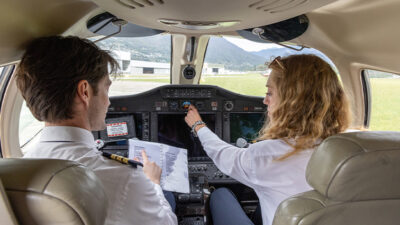Making your Risk Assessment Tool a STAR

Mention the acronym GUMPS to just about any fixed wing pilot and watch their eyes move upward and to the right. Their neurolinguistics are probably showing you they are visually remembering: gas, undercarriage, mixture, props and safety. It is a tried-and-true mental checklist and litany that has served, and saved, many a pilot.
While implementing new safety management systems in all types of organizations, I’ve continued to look for GUMP-style acronyms and checklists that help operators integrate SMS principles in their work processes and influence behaviors that promote a proactive safety culture. Getting people to accurately risk assess tasks, plans or procedures is not as easy as it sounds. Make the assessment tool criteria too complex, restrictive or incomplete, and people may attempt to game, minimize or avoid its results. Make the assessment too simplistic or unrealistic, and the decision tool data becomes meaningless.
Since meaningful form names help users integrate their function, I always ask front-line employees what they call, or wish to name, their SMS risk assessment tool. As rewarding as it is to hear some say, “We do a Baldwin,” the name may not create the right mindset nor set the tone for what is at stake. While implementing an SMS for a large aircraft maintenance supplier, I went as far as offering steak dinners to their technicians if they could rename their risk assessment tool something other than “The RAT.”
A Memorable and Meaningful Risk Tool Acronym
My risk tool name search continued until very recently when I attended an excellent webinar presented by Helicopter Association International, (HAI@Work Webinar: Elevating Vertical Flight Through Mentoring). One of HAI’s key presenters was Jan Becker, CEO of Becker Helicopter Pilot Academy. As part of her safety mentoring presentation, she shared that her pilots, aircraft engineers and ground support staff utilize a “STAR” risk checklist. STAR: Stop, Think, Assess and Report – what an absolutely perfect acronym for setting the tone, norms, expectations and actions needed to complete a risk assessment!
I present you a sample of an aircraft maintenance STAR checklist in action:
STOP – Am I working in a safety culture where anyone can pull the “Andon cord?”1
- Am I feeling pressures of fatigue, complacency, time, peer work, personal events, task saturation, situational awareness or distractions/interruptions?
- How well do I feel physically in terms of general health, hearing, sight, stress, memory recall, rest and body size/strength?
- Do I lack the assertiveness to warn of any of these conditions?
THINK – What is the status of my knowledge, skills and abilities?
- Do I have the knowledge to perform the task?
- Do I have the technical data to perform the task?
- Have I performed the task previously?
- Do I have the proper tools and equipment to perform the task?
- Have I had the proper training to support the job task?
- Am I both mentally and physically prepared to perform the job task?
- Have I taken the proper safety precautions to perform the task?
- Do I have the resources available to perform the task?
- Have I researched all regulations, standards and policies to ensure compliance and conformance?
ASSESS – Methodically and objectively complete the SMS risk assessment form. Ignore any running risk score totals, colors or trend indications until you have identified and assessed each static and dynamic condition.
- Have you applied and reviewed all possible mitigations and protections?
- Are your personal minimums higher than customer, company or regulatory minimums?
REVIEW and REPORT – Am I working in a safety culture that promotes continuous improvement of personal minimums, rewards continuous learning and schedules equal time for reporting/process improvement/mentoring as the task itself?
- Did the risk assessment form accurately capture all safety elements of the task or mission?
- Did I perform the job task to the best of my abilities?
- Was the job task performed to be equal to the original?
- Was the job task performed in accordance with appropriate data?
- Did I use all the methods, techniques and practices acceptable to the industry?
- Did I perform the job task without pressures, stress and distractions?
- Did I reinspect my work or have someone inspect my work before returning to service?
- Did I make the proper record entries for the work performed?
- Did I perform the operational checks after the work was completed?
- Am I willing to sign on the bottom line for the work performed?
- Am I willing to fly in the aircraft once it is approved for the return to service?
Just as GUMPS has led to many safe flights over the years, I hope that hearing STAR will soon make us stop, look up and thank everyone who took the time to thoroughly complete a risk assessment.
Resources
1 The Andon Cord is a product of Jidoka – a concept that empowers operators to detect abnormal conditions and immediately stop work. Jidoka, created by Toyota in the early 1900s, is one of the founding pillars of the Toyota Production System, and the Andon Cord is one of the most well-known examples of the concept at work. Admin, (January 8, 2018). The Andon Cord: A Way to Stop Work While Boosting Productivity. Six Sigma Daily Retrieved from https://www.sixsigmadaily.com/what-is-an-andon-cord/

Customized Safety/Quality Management programs and related business solutions developed by experienced and credentialed safety professionals include training, manual management and SMS implementation/software. Based on ICAO and other international standards and regulations, Baldwin’s programs support Business Aviation, Charter, MRO, Ground Operations and Handling, FBO, Airport, Medical Transport, UAS and Regional Airlines by providing scalable/flexible software, an outstanding customer experience, and our Commitment to Excellence.
http://www.baldwinaviation.com/
© 2024 Baldwin Safety & Compliance. All Rights Reserved.
Next ArticleRelated Posts

Understanding the Challenge of Turbulence-Related Injuries in Business Aviation
The challenge of managing air turbulence in business and private aviation is becoming increasingly evident due to the growing number of turbulence-related incidents affecting aircraft operators across the industry.

Safety in Numbers: Trends in Aviation Accidents and Incidents
Every accident is preventable; the problem is that we don’t know how to prevent it until after the accident happens. However, what we can do as an industry is honor the anguish of each event by sharing the information, the mistakes and the outcomes to improve safety for everyone.

